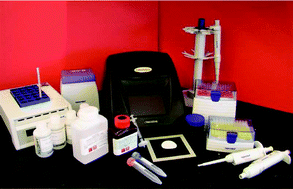In the occupational hygiene field, polyvinyl alcohol (PVA)-based wipe materials are used extensively for beryllium (Be) sample collection and analysis. Hence there is a need for validated methods to determine trace Be in such sampling media. In this work an interlaboratory study was carried out to evaluate the performance of an extraction and fluorescence method for determining trace Be in PVA wipes containing refractory beryllium oxide (BeO). The method entails heated extraction with dilute ammonium bifluoride (NH4HF2), followed by fluorescence measurement of extracted Be in extract aliquots after reaction with the high quantum-yield fluorophore, hydroxybenzoquinoline sulfonate (HBQS). Certified BeO-spiked PVA wipe materials were prepared at six different levels ranging from 0.030 to 5.6 μg Be per wipe. Dry wipe materials and wipes wetted with 0.5 mL of deionized water were spiked as above. Duplicates of these materials, plus media blanks, were distributed to eight participating laboratories; spiking levels were unknown to the volunteers. Each participant was requested to carry out extraction and fluorescence measurement in accordance with an ASTM International standard test method, ASTM D7202, and to report their results in units of μg Be per wipe sample. Interlaboratory precision, as estimated by percent relative standard deviations (RSDs), ranged between 4.5% and 16%. Estimated percent Be recoveries were 90–99% for dry wipes and between 87 and 93% for wetted wipe materials after volume correction for water content.

You have access to this article
 Please wait while we load your content...
Something went wrong. Try again?
Please wait while we load your content...
Something went wrong. Try again?


 Please wait while we load your content...
Please wait while we load your content...